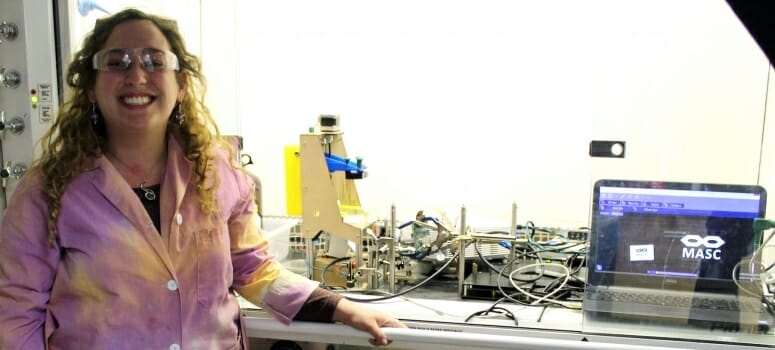Mar 13 2019
3D printing has transformed the fields of healthcare, manufacturing, biomedical engineering, and art design.
 Graduate student Johanna Schwartz next to the multimaterial printing setup that she built. (Image courtesy - A.J. Boydston and Johanna Schwartz)
Graduate student Johanna Schwartz next to the multimaterial printing setup that she built. (Image courtesy - A.J. Boydston and Johanna Schwartz)
Successful applications have been launched regardless of the fact that a majority of 3D printing methods can only create parts made of a single material at a time. More complex applications could be formed if 3D printers could use a variety of materials and produce multi-material parts.
A new study uses a range of wavelengths of light to attain this complexity. Researchers at the University of Wisconsin–Madison built a novel 3D printer that uses patterns of visible and UV light to direct which of two monomers are polymerized to develop a solid material. Various patterns of light offer the spatial control required to produce multi-material parts. The work was reported in the February 15th issue of the journal Nature Communications.
“As amazing as 3D printing is, in many cases it only offers one color with which to paint,” says UW–Madison Professor of Chemistry A.J. Boydston, who led the latest work with his graduate student Johanna Schwartz. “The field needs a full color palette.”
Boydston and Schwartz knew that enhanced printing materials required a chemical method to complement engineering progress.
This is a shift in how we think about 3D printing with multiple types of materials in one object. This is more of a bottom-up chemist’s approach, from molecules to networks.
A.J. Boydston, Professor of Chemistry, UW–Madison.
3D printing is the process of creating solid 3D objects from a digital file by consecutively incorporating thin layers of material on top of earlier layers. A majority of multi-material 3D printing techniques use individual reservoirs of materials to obtain different materials in the correct positions.
But Boydston understood that a one-vat, multiple-component method—resembling a chemist’s one-pot approach when synthesizing molecules—would be more useful than several reservoirs with various materials. This method is grounded on the ability of diverse wavelengths of light to manipulate which starting materials polymerize into various sections of the solid product. Those starting materials begin as simple chemicals, called monomers that polymerize together into a longer string of chemicals, similar to how plastic is produced.
If you can design an item in PowerPoint with different colors, then we can print it with different compositions based on those colors.
Johanna Schwartz, Graduate Student, UW–Madison.
Scientists form numerous digital images that, when stacked, yield a 3D design. The images control whether UV or visible light is used to polymerize the starting materials, which manipulates the final material and its properties, such as stiffness. The team concurrently aims light from two projectors toward a vat of liquid starting materials, where layers are erected one-by-one on a platform. After one layer is erected, the build platform moves up, and light helps form the next layer.
The key obstacle Boydston and Schwartz faced was enhancing the chemistry of the starting materials. They first pondered over how the two monomers would act together in one vat. They also had to confirm that the monomers had similar curing times so that the soft and hard materials within each layer finished drying at roughly the same time.
With the accurate chemistry set up, Boydston and Schwartz could currently order precisely where each monomer cured within the printed object by using UV or visible light.
At this stage, we’ve only accomplished putting hard materials next to soft materials in one step. There are many imperfections, but these are exciting new challenges.
A.J. Boydston, Professor of Chemistry, UW–Madison.
Currently, Boydston wants to look into these inadequacies and answer open questions, such as what other monomer mixtures can be used and whether diverse wavelengths of light can be utilized to cure these new materials. Boydston also hopes to bring together an interdisciplinary team that can boost the influence of wavelength-regulated, multi-material 3D printing.
The novel approach of the researchers to multi-material 3D printing could allow engineers, artists, designers, and scientists to develop considerably more intricate systems using 3D printing. Applications could include the designing of tailored medical devices, such as prostheses, or the development of simulated tissues and organs. Medical students could use these synthetic organs to train themselves instead of, or before dealing with, live patients.
Using chemical approaches to eradicate an engineering bottleneck is precisely what the 3D printing sector needs to march forward, says Schwartz.
“It is this interface of chemistry and engineering that will propel the field to new heights,” Schwartz says.
This research was sponsored by the Army Research Office (Grant No. W911NF-17-1-0595) and the National Science Foundation Graduate Research Fellowship Program (J.J.S.–Grant No. DGE-1256082).